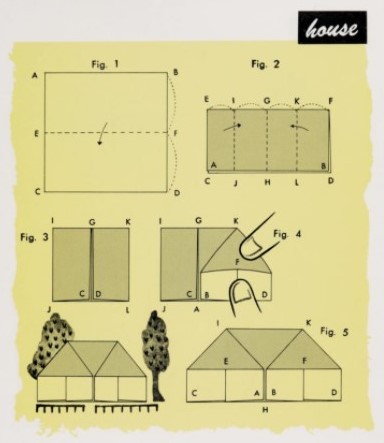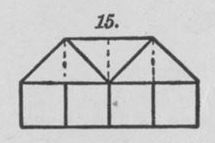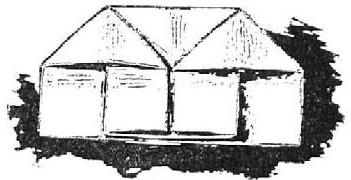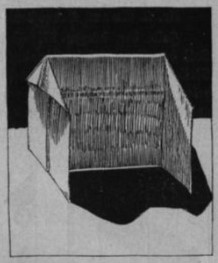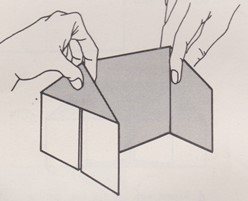| The Public Paperfolding History Project
Last updated 24/2/2024 x |
|||||||
| The House | |||||||
| This
page is being used to collect information about the
history of the origami design known as the House and its
various derivative designs. Please contact me if you know
any of this information is incorrect or if you have any
other information that should be added. Thank you. This page is about the House either as a design in its own right or appearing as a base. There is a separate page for Designs Derived from the House. The House can appear in either flat or three-dimensional form. ********** In Japan (and in publications by Japanese authors) In his article 'History of Origami in the East and the West before Interfusion', published in 'Origami 5: Fifth International Meeting of Origami, Science, Mathematics and Education' in 2011, Koshiro Hatori asserts that, ''Many of the European origami models contained in Krause-Boelte's book (ie 'The Kindergarten Guide') are not included in contemporary Japanese records. The pig, house, sofa (also known as piano or organ), balloon (waterbomb), arrow (paper plane), salt cellar (cootie catcher), bird (pajarita or cocotte) and windmill ... were all born in Europe and imported into Japan along with the kindergarten system.' ********** 1951 This version of the House, in which the top of the roof has been sunken inside the design to lower the roof-line, appears in 'Origami to Kirinuki' by Saburo Ueda, which was published by Kokkado in Tokyo, most probably in 1951.
A second, cut, version also appears in the same work as 'In the Middle of Nowhere'.
********** 1957 The House appears in 'Origami: Book One' by Florence Sakade, which was published by the Charles E Tuttle Company in Rutland, Vermont and Tokyo in 1957.
********** In Europe and the Americas 1882 As far as I know the House first appears in the historical record in part two of 'The Kindergarten Guide' by Maria Kraus Boelte and John Kraus, which was probably first published by E. Steiger and Company in New York in 1882.
********** 1907 The House appears as a base for other designs, though not as a design in its own right, in an article titled 'El trabajo manual escolar' by Vicente Casto Legua in the January 1907 issue of the Spanish magazine 'La Escuela Moderna' which was published in Madrid by Los Sucesores de Hernando.
********** 1923 A taller variation of the house appear as a 'groundform' for fold and cut designs in 'Falten und Formen mit Papier' by Richard Rothe which was published by Deutscher Verlag für Jugend und Volk in Vienna and Leipzig in 1923.
********** 1963 The House appears in its three-dimensional form in 'Folding Paper Toys' by Shari Lewis and Lillian Oppenheimer, which was first published by Stein and Day, Inc in the USA in 1963.
********** 1968 The House also appears in 'Teach Yourself Origami: The Art of Paperfolding' by Robert Harbin, which was published by The English Universities Press in 1968, where it is said to be a 'simple Japanese Fold'.
********** |
|||||||


